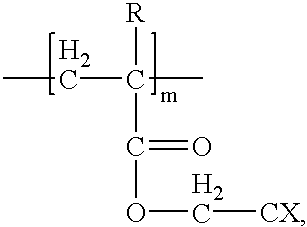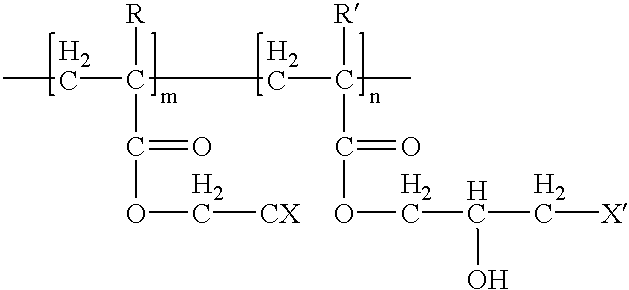Halogenated anti-reflective coatings
a technology of anti-reflective coating and halogenated polymer, which is applied in the direction of photosensitive materials, instruments, photomechanical equipment, etc., can solve the problems of reducing the image quality of the processed photoresist, and reducing the resolution of the photoresis
- Summary
- Abstract
- Description
- Claims
- Application Information
AI Technical Summary
Problems solved by technology
Method used
Image
Examples
example 2
In this example, copolymers were halogenated on the backbone of the copolymer, and the etch selectivity of the halogenated copolymer was determined as compared to a reference (P-HPMA). The tested copolymers are represented by Formulas II-IV. The etch selectivity results are set forth in Table 2. The etch rate was not improved or only mildly improved when halogens were added directly to the polymer backbone. ##STR4##
Poly-hydroxypropylmethacrylate (P-HPMA) ##STR5## ##STR6## ##STR7##
example 3
In this example, copolymers were halogenated on functional groups of the copolymer (i.e., the halogens were not attached directly to the polymer backbone) which was grafted with a chromophore. The respective etch selectivities of the resulting ARCs were determined as compared to a reference (DUV42, see Formula V). The tested copolymers are represented by Formula VI. The etch selectivity results are set forth in Table 3. ##STR8## ##STR9##
Where "R" is --H or --CH.sub.3, and "X" is --F.sub.3 or --Cl.sub.3, as indicated in Table 3.
example 4
In this example, copolymers were halogenated on a functional group of the copolymer (i. e., the halogens were not attached directly to the polymer backbone) which was grafted with a chromophore similar to Example 3. The etch selectivity of the ARC was then determined. The copolymers of the polymer binder in the tested ARC are represented by Formula VII, with varying molar ratios of "m" and "n" being tested. The etch selectivity results are set forth in Table 4. These results indicate that ARCs formed with polymers having halogentated functional groups can have the molar ratio of the copolymer members varied to adjust the properties of the ARC. ##STR10##
PUM
| Property | Measurement | Unit |
|---|---|---|
| weight average molecular weight | aaaaa | aaaaa |
| temperature | aaaaa | aaaaa |
| weight average molecular weight | aaaaa | aaaaa |
Abstract
Description
Claims
Application Information
 Login to View More
Login to View More - R&D
- Intellectual Property
- Life Sciences
- Materials
- Tech Scout
- Unparalleled Data Quality
- Higher Quality Content
- 60% Fewer Hallucinations
Browse by: Latest US Patents, China's latest patents, Technical Efficacy Thesaurus, Application Domain, Technology Topic, Popular Technical Reports.
© 2025 PatSnap. All rights reserved.Legal|Privacy policy|Modern Slavery Act Transparency Statement|Sitemap|About US| Contact US: help@patsnap.com



